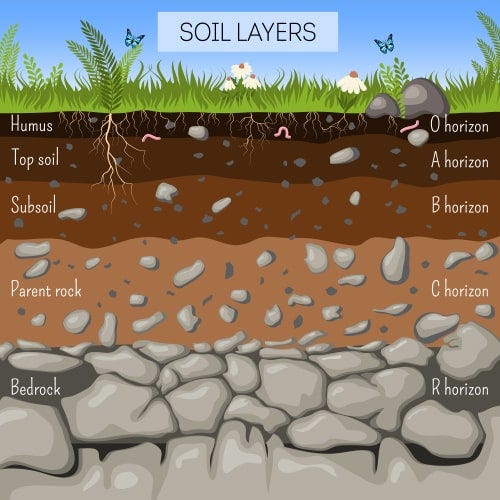Gardening is a relaxing, enjoyable pastime for many, and extremely rewarding once plants and shrubs start to flourish. However, there is much to learn – you don’t just place a bulb in the soil and hope for the best, there’s a lot more to it than that. If you are a novice when it comes to gardening/landscape design, you may have heard of topsoil but you might not necessarily know what it is used for or how it differs from compost. Not to worry, we’re here to clear up a few facts for you in this beginner’s guide…
What is Topsoil?
As the name suggests, topsoil is the uppermost layer of earth – usually the first 2-8 inches. It is formed over many years as rocks break down and dead animals/bugs and leaves mix into it. It can take over one hundred years to form. As a result, topsoil contains a huge amount of natural nutrients and minerals, including nitrogen, potassium, magnesium, phosphorus etc, which help plants to grow. The more organic matter the soil contains, the darker it will look.
Beneath the topsoil is a layer called subsoil, which doesn’t tend to contain as much organic matter and is usually rockier and sandier. With that said, your plants actually rely on the layer of topsoil to ensure they are getting the right amount of water and nutrients.
There are lots of different variations of topsoil, and it can differ in quality. However, the main categories are screened and unscreened. When topsoil is screened, it essentially means that it has been put through a meshing process to filter out any big chunks, such as stones. Screened topsoil is an affordable option and highly versatile. Most commonly, the soil is sieved to remove any stones whilst sand and lime is added in order to neutralize the pH of the soil.
A common misconception is that topsoil is compost. It is not! Compost is higher in nutrients and pesticides and is used in smaller pots and troughs.

What is Topsoil Used for?
As topsoil improves the quality of soil on any patch of land by providing important nutrients, it is widely popular amongst gardeners and landscapers. It is great for ensuring that plants, shrubs, vegetables grow in a healthy, well-nourished way, so is ideal for filling up raised flower beds. It’s not a good idea to fill your containers with topsoil, as it won’t drain very well and can make your pots heavy – stick with a potting mix in your containers. Mix topsoil with any existing soil in your garden to improve its pH and nutrient quality.
In addition to being used in flower beds, many gardeners and landscapers also use topsoil for larger projects, like levelling out existing gardens, repairing a damaged lawn, growing an entirely new patch of grass, or even in public places such as parks.
Topsoil is commonly used after newly finished projects to ensure the garden is fertile and grass can grow. Usually, soil or hardcore produced by foundation digging is used to level out any outside space. As it comes from the layer beneath the topsoil, it usually has lower nutrient density and the incorrect pH to promote plant growth. Top soil can be mixed and spread out amongst your garden to counteract this!

The Benefits of Decorative Chippings | Landscaping Blogs | Lawsons
How to Use Topsoil for Winter | Landscaping Blogs | Lawsons
3 Decorative Landscaping Ideas | Landscaping Blogs | Lawsons

